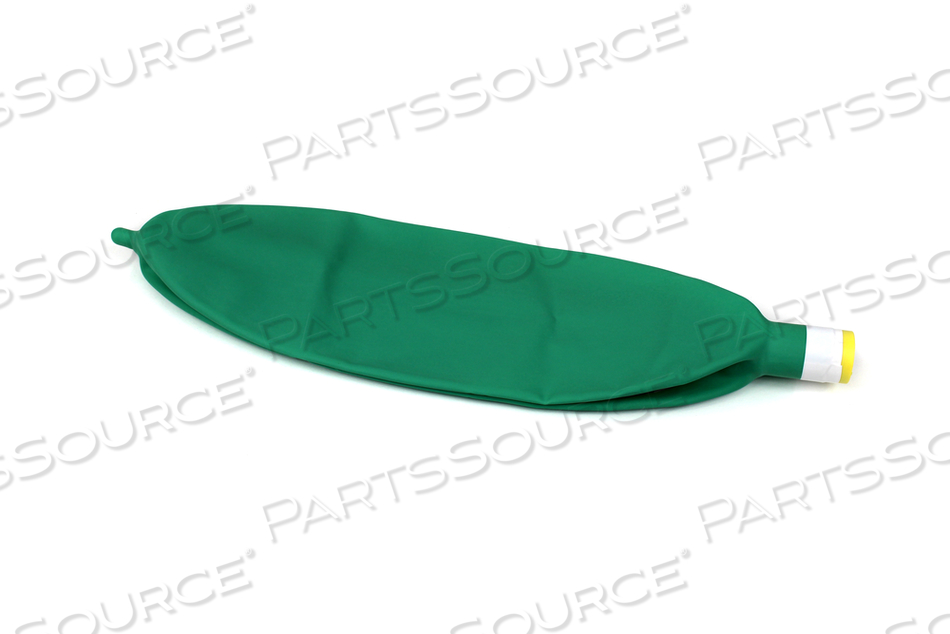NON CONDUCTIVE GAS EVACUATION RESERVOIR BAG by Datex-Ohmeda




OEM#: 0225-3212-700NON CONDUCTIVE GAS EVACUATION RESERVOIR BAG by Datex-Ohmeda

Not For Export Out Of US
The Non Conductive Gas Evacuation Reservoir Bag is a collapsible gas container from which gases are inhaled and exhaled during general anesthesia ventilation. The anesthesia delivery system provides a set of reservoir bags along with a bushing as a part of breathing circuit system for robust manual ventilation (bagging) by changing the mode from VENT (Mechanical) to BAG (Manual). The bag is excluded from traditional breathing system when the mechanical ventilator was in use. When the patient inspires, the mechanical ventilator cannot cope with the immediate demands. It cannot provide sufficient fresh gas flow to satisfy the sudden inspiratory requirements of the lungs. This problem is overcome by inserting a reservoir bag between the anesthetic machine and the patient. It allows gas to accumulate during exhalation (CO₂) and provides gas for next inspiration (Oxygenating) thus causing rebreathing. It is a visible monitor of respiratory rate and depth. The neck of the bag is the part that connects with breathing system. The tail end of the bag has control valve for adjustments depending upon the required leak.
Additional Features:
- Good chemical stability
- Flexible over a wide temperature range
- Maintains pressure for 45 seconds with a maximum pressure drop of 2.5mm Hg
- Can withstand 3.4 LB longitudinal force
The Non Conductive Gas Evacuation Reservoir Bag is a collapsible gas container from which gases are inhaled and exhaled during general anesthesia ventilation. The anesthesia delivery system provides a set of reservoir bags along with a bushing as a part of breathing circuit system for robust manual ventilation (bagging) by changing the mode from VENT (Mechanical) to BAG (Manual). The bag is excluded from traditional breathing system when the mechanical ventilator was in use. When the patient inspires, the mechanical ventilator cannot cope with the immediate demands. It cannot provide sufficient fresh gas flow to satisfy the sudden inspiratory requirements of the lungs. This problem is overcome by inserting a reservoir bag between the anesthetic machine and the patient. It allows gas to accumulate during exhalation (CO₂) and provides gas for next inspiration (Oxygenating) thus causing rebreathing. It is a visible monitor of respiratory rate and depth. The neck of the bag is the part that connects with breathing system. The tail end of the bag has control valve for adjustments depending upon the required leak.
Additional Features:
- Datex-Ohmeda
- AESTIVA/5
The Non Conductive Gas Evacuation Reservoir Bag is a collapsible gas container from which gases are inhaled and exhaled during general anesthesia ventilation. The anesthesia delivery system provides a set of reservoir bags along with a bushing as a part of breathing circuit system for robust manual ventilation (bagging) by changing the mode from VENT (Mechanical) to BAG (Manual). The bag is excluded from traditional breathing system when the mechanical ventilator was in use. When the patient inspires, the mechanical ventilator cannot cope with the immediate demands. It cannot provide sufficient fresh gas flow to satisfy the sudden inspiratory requirements of the lungs. This problem is overcome by inserting a reservoir bag between the anesthetic machine and the patient. It allows gas to accumulate during exhalation (CO₂) and provides gas for next inspiration (Oxygenating) thus causing rebreathing. It is a visible monitor of respiratory rate and depth. The neck of the bag is the part that connects with breathing system. The tail end of the bag has control valve for adjustments depending upon the required leak.
Additional Features:
- Good chemical stability
- Flexible over a wide temperature range
- Maintains pressure for 45 seconds with a maximum pressure drop of 2.5mm Hg
- Can withstand 3.4 LB longitudinal force
The Non Conductive Gas Evacuation Reservoir Bag is a collapsible gas container from which gases are inhaled and exhaled during general anesthesia ventilation. The anesthesia delivery system provides a set of reservoir bags along with a bushing as a part of breathing circuit system for robust manual ventilation (bagging) by changing the mode from VENT (Mechanical) to BAG (Manual). The bag is excluded from traditional breathing system when the mechanical ventilator was in use. When the patient inspires, the mechanical ventilator cannot cope with the immediate demands. It cannot provide sufficient fresh gas flow to satisfy the sudden inspiratory requirements of the lungs. This problem is overcome by inserting a reservoir bag between the anesthetic machine and the patient. It allows gas to accumulate during exhalation (CO₂) and provides gas for next inspiration (Oxygenating) thus causing rebreathing. It is a visible monitor of respiratory rate and depth. The neck of the bag is the part that connects with breathing system. The tail end of the bag has control valve for adjustments depending upon the required leak.
Additional Features:
- Datex-Ohmeda
- AESTIVA/5
The Non Conductive Gas Evacuation Reservoir Bag is a collapsible gas container from which gases are inhaled and exhaled during general anesthesia ventilation. The anesthesia delivery system provides a set of reservoir bags along with a bushing as a part of breathing circuit system for robust manual ventilation (bagging) by changing the mode from VENT (Mechanical) to BAG (Manual). The bag is excluded from traditional breathing system when the mechanical ventilator was in use. When the patient inspires, the mechanical ventilator cannot cope with the immediate demands. It cannot provide sufficient fresh gas flow to satisfy the sudden inspiratory requirements of the lungs. This problem is overcome by inserting a reservoir bag between the anesthetic machine and the patient. It allows gas to accumulate during exhalation (CO₂) and provides gas for next inspiration (Oxygenating) thus causing rebreathing. It is a visible monitor of respiratory rate and depth. The neck of the bag is the part that connects with breathing system. The tail end of the bag has control valve for adjustments depending upon the required leak.
Additional Features:
- Good chemical stability
- Flexible over a wide temperature range
- Maintains pressure for 45 seconds with a maximum pressure drop of 2.5mm Hg
- Can withstand 3.4 LB longitudinal force
The Non Conductive Gas Evacuation Reservoir Bag is a collapsible gas container from which gases are inhaled and exhaled during general anesthesia ventilation. The anesthesia delivery system provides a set of reservoir bags along with a bushing as a part of breathing circuit system for robust manual ventilation (bagging) by changing the mode from VENT (Mechanical) to BAG (Manual). The bag is excluded from traditional breathing system when the mechanical ventilator was in use. When the patient inspires, the mechanical ventilator cannot cope with the immediate demands. It cannot provide sufficient fresh gas flow to satisfy the sudden inspiratory requirements of the lungs. This problem is overcome by inserting a reservoir bag between the anesthetic machine and the patient. It allows gas to accumulate during exhalation (CO₂) and provides gas for next inspiration (Oxygenating) thus causing rebreathing. It is a visible monitor of respiratory rate and depth. The neck of the bag is the part that connects with breathing system. The tail end of the bag has control valve for adjustments depending upon the required leak.
Additional Features:
- Datex-Ohmeda
- AESTIVA/5
